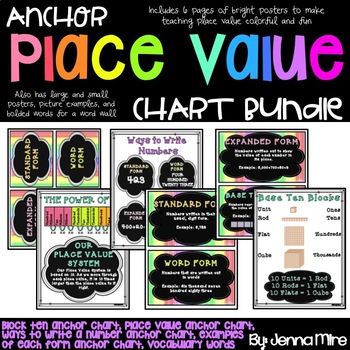Place Value Anchor Charts
MsMireIsHere
806 Followers
Grade Levels
1st - 5th
Subjects
Resource Type
Standards
CCSS1.NBT.A.1
CCSS2.NBT.A.1
CCSS2.NBT.B.9
CCSS3.NBT.A.1
CCSS4.NBT.A.2
Formats Included
- PDF
Pages
8 pages
MsMireIsHere
806 Followers
What educators are saying
This was perfect for my students. They really need the visuals and I put these on the board so they could see them. Thank you so much!
Love the colors ! My students were struggling with place value so I purchased these for my math wall. It's been a game changer for some of my students last year some kids just need a visual!
Description
INCLUDES:
• Block Ten anchor chart (units, rod, flats, cubes)
• Place Value anchor chart (ones-hundred millions)
• Ways to write a number anchor chart (Standard form, word form, base ten blocks, expanded form)
• Examples of each form (Standard form, word form, base ten blocks, expanded form)
• Vocabulary words (Standard form, word form, base ten blocks, expanded form)
Use: Print, cut, laminate, cut, and tape or put a magnet to the back of the examples and words to use on the board or word wall. Print and use as mini anchor charts at tables.
Total Pages
8 pages
Answer Key
N/A
Teaching Duration
N/A
Report this resource to TPT
Reported resources will be reviewed by our team. Report this resource to let us know if this resource violates TPT’s content guidelines.
Standards
to see state-specific standards (only available in the US).
CCSS1.NBT.A.1
Count to 120, starting at any number less than 120. In this range, read and write numerals and represent a number of objects with a written numeral.
CCSS2.NBT.A.1
Understand that the three digits of a three-digit number represent amounts of hundreds, tens, and ones; e.g., 706 equals 7 hundreds, 0 tens, and 6 ones. Understand the following as special cases:
CCSS2.NBT.B.9
Explain why addition and subtraction strategies work, using place value and the properties of operations.
CCSS3.NBT.A.1
Use place value understanding to round whole numbers to the nearest 10 or 100.
CCSS4.NBT.A.2
Read and write multi-digit whole numbers using base-ten numerals, number names, and expanded form. Compare two multi-digit numbers based on meanings of the digits in each place, using >, =, and < symbols to record the results of comparisons.





